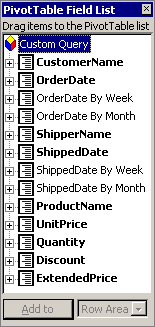About the toolbar, field list, and Commands and Options dialog box
The toolbar in a PivotTable list appears at the top of the list and provides a set of commands that you can use to work with the data in the PivotTable list. Rest the pointer on each toolbar button to display the name of its command.

If you don't see the toolbar, the designer of the PivotTable list might have disabled it.
 The PivotTable list field list
The PivotTable list field list
Use the field list to view the fieldsets and fields that are available from the source data and to add fields to the row, column, filter, data, and detail areas of the PivotTable list. You can scroll and click the expand indicators ( or
or  boxes) next to a fieldset to show or hide fields. In the field list, the fields that are not bold are available but not yet displayed in the PivotTable list. The bold fields are already displayed.
boxes) next to a fieldset to show or hide fields. In the field list, the fields that are not bold are available but not yet displayed in the PivotTable list. The bold fields are already displayed.

You might not be able to show the field list if the designer of the PivotTable list chose to disable it.
 The Commands and Options dialog box
The Commands and Options dialog box
Use this dialog box to do common tasks, such as filtering data, formatting text, and showing or hiding elements. The Commands and Options dialog box includes some commands that aren't present on the toolbar or shortcut menus. The tabs displayed in the dialog box change as you select different parts of a PivotTable list. If you select a control on the Web page other than a PivotTable list or other Microsoft Office Web Component, the dialog box is hidden until you activate the component again.
You might not be able to show the Commands and Options dialog box if the designer of the PivotTable list chose to disable it.
